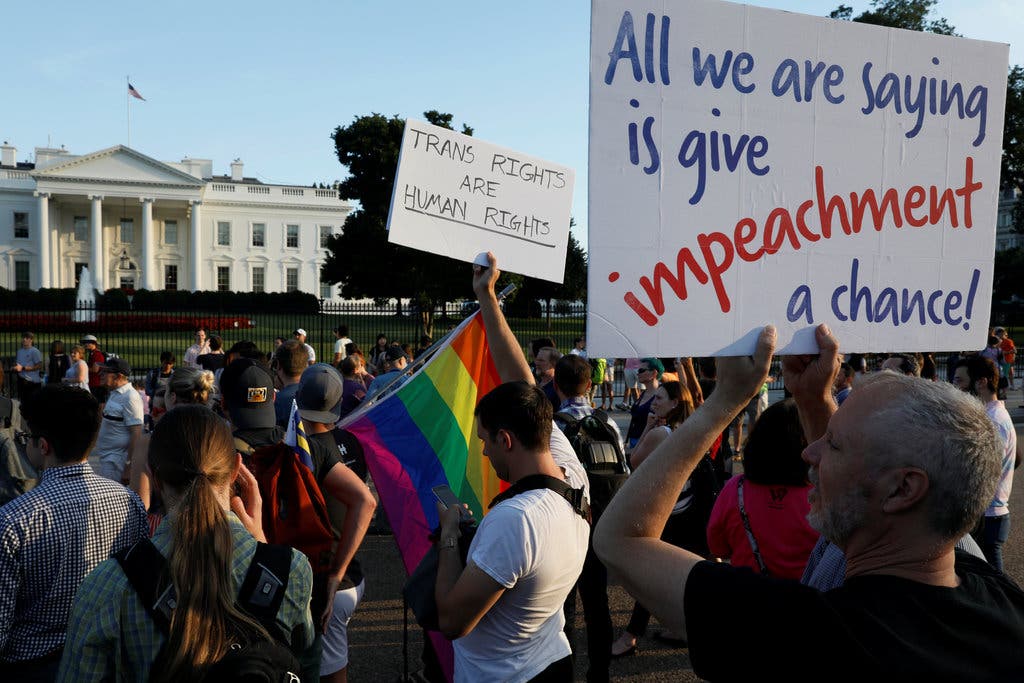Trump's Transgender Military Ban: A Critical Examination Of The Rhetoric

Table of Contents
The Rhetoric of National Security and Combat Readiness
A central argument used to justify the ban centered on the notion that transgender individuals pose a threat to national security and hinder combat readiness. The Trump administration, and its supporters, repeatedly claimed that the inclusion of transgender service members would compromise military effectiveness and create undue burdens. Examples of this rhetoric can be found in numerous statements and tweets from the former president and high-ranking officials.
- Lack of Empirical Evidence: Crucially, these claims lacked empirical evidence. No credible studies supported the assertion that transgender individuals are inherently less capable of serving effectively in the military. Existing data, in fact, often shows transgender service members performing at similar or even higher levels than their cisgender counterparts.
- Discriminatory Bias: The argument regarding national security and combat readiness often masked underlying discriminatory biases. The rhetoric tapped into existing prejudices against transgender individuals, framing their presence as a disruptive and inherently problematic element within the military structure. This played into broader societal anxieties around gender identity and its place within traditional institutions.
- Impact on Public Perception: This rhetoric significantly shaped public perception of transgender individuals, fostering negative stereotypes and reinforcing harmful misconceptions about their capabilities and contributions. The framing of transgender service members as a threat directly contributed to the stigmatization and marginalization of this community.
The Rhetoric of Cost and Burden
Another key element of the rhetoric surrounding the transgender military ban was the argument of cost and burden. Proponents of the ban claimed that providing healthcare and accommodating the needs of transgender service members would place an undue financial strain on the military budget. Statements emphasizing the supposed financial burden were frequently used to justify the policy.
- Actual Costs vs. Perceived Costs: Analysis revealed that the actual costs associated with providing healthcare and transition-related services for transgender service members were relatively modest when compared to the overall military budget. The emphasis on financial concerns served as a convenient scapegoat, deflecting attention from the discriminatory nature of the ban.
- Comparison to Other Expenditures: The purportedly exorbitant costs of transgender healthcare were frequently presented out of context, without comparing them to other far larger military expenses. This created a distorted perception of the financial implications of inclusivity.
- Potential Economic Benefits of Inclusivity: Furthermore, the argument ignores the potential economic benefits of a more inclusive military. A diverse and inclusive force attracts a wider pool of talent, improves morale, and enhances the military's overall effectiveness.
The Rhetoric of Morality and Traditional Values
The justification for the ban also frequently invoked arguments based on morality, tradition, and religious beliefs. The rhetoric frequently appealed to traditional gender roles and definitions of masculinity and femininity, often subtly (or not-so-subtly) suggesting that transgender individuals did not conform to these idealized norms.
- Separation of Church and State: The use of religious rhetoric to justify military policy directly conflicts with the principle of separation of church and state. The military is a secular institution, and its policies should not be based on religious beliefs or interpretations.
- Use of Religious Rhetoric to Justify Discrimination: The invocation of religious arguments served to legitimize discrimination against transgender individuals, masking prejudice under the guise of moral righteousness. This tactic has historically been used to justify exclusion and oppression against various marginalized groups.
- Historical Context: This type of rhetoric echoes historical arguments used to exclude LGBTQ+ individuals from various aspects of society. Understanding this historical context is crucial to appreciating the deeper implications of the transgender military ban.
The Impact of the Rhetoric on Transgender Individuals and the Military
The rhetoric surrounding the transgender military ban had devastating real-world consequences for transgender individuals and the military as a whole. The ban itself, coupled with the negative rhetoric surrounding it, created a climate of fear and discrimination.
- Mental Health and Well-being: The ban and associated rhetoric negatively impacted the mental health and well-being of transgender service members, increasing rates of anxiety, depression, and suicide attempts.
- Recruitment and Retention: The ban directly impacted recruitment and retention efforts. The policy signaled a lack of inclusivity and deterred qualified individuals from seeking military service.
- Military Morale and Cohesion: The controversy surrounding the ban damaged morale and cohesion within the military, undermining trust and creating divisions within the ranks. A diverse and inclusive environment is critical for a strong and effective military.
- Broader Implications for LGBTQ+ Inclusion: The ban and its accompanying rhetoric set a harmful precedent, impacting the broader struggle for LGBTQ+ inclusion in all aspects of society.
Conclusion: Understanding the Lasting Impact of Trump's Transgender Military Ban Rhetoric
The rhetorical analysis presented here demonstrates the lack of evidence supporting the justifications for the Trump administration's transgender military ban. The arguments deployed – concerning national security, cost, and morality – were largely based on prejudice and misinformation, rather than sound reasoning or empirical data. The harmful effects of this discriminatory rhetoric are undeniable, impacting the mental health of transgender individuals, damaging military morale, and setting a dangerous precedent for future policies. It is crucial to continue the critical examination of the transgender military ban and its lasting impact. We must actively promote discussions and advocate for policy changes that prioritize inclusivity, equality, and respect for the rights of all service members, regardless of gender identity. Further research into the rhetoric surrounding transgender military service is vital to ensure informed advocacy for change and the dismantling of discriminatory practices.

Featured Posts
-
 Reactions Young Thug On The Not Like U Track And His Recent Release
May 10, 2025
Reactions Young Thug On The Not Like U Track And His Recent Release
May 10, 2025 -
 The Future Of Apple Navigating The Ai Landscape
May 10, 2025
The Future Of Apple Navigating The Ai Landscape
May 10, 2025 -
 Strictly Star Wynne Evans Faces Backlash Removed From Go Compare Campaign
May 10, 2025
Strictly Star Wynne Evans Faces Backlash Removed From Go Compare Campaign
May 10, 2025 -
 Arkema Premiere Ligue Dijon S Incline Face Au Psg
May 10, 2025
Arkema Premiere Ligue Dijon S Incline Face Au Psg
May 10, 2025 -
 Breaking News Arrest In Elizabeth City Weekend Shooting Investigation
May 10, 2025
Breaking News Arrest In Elizabeth City Weekend Shooting Investigation
May 10, 2025
